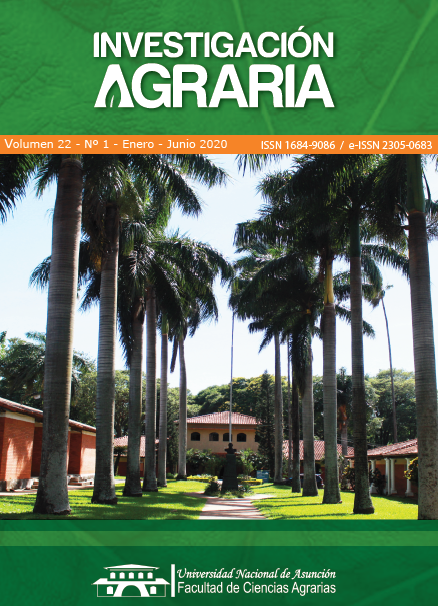Physicochemical characterization of the pulp and kernel of Acrocomia aculeata
DOI:
https://doi.org/10.18004/investig.agrar.2020.junio.46-52%20Keywords:
mbokaja, coco, fruits, lipids, proteinsAbstract
The fruit of Acrocomiaaculeata, locally known as “coco” or “mbokaja” in Guaraní language is a native species abundant in Paraguayan soil, whose kernel and pulp contain important amounts of proteins, fibers, carbohydrates, lipids, vitamins and minerals, with a high potential for consumption both in natural form or for its use in food production. This study aimed to evaluate physicochemical aspects and nutritional compounds of the fruits. The different fractions of the fruit were evaluated and the edible portion was determined using gravimetric methods. The solvent extraction method (Soxhlet) determined the total lipid content, the Kjeldahl method determined the protein, the anthrone method (spectrophotometry) determined the total carbohydrate content. The mineral residue was determined by calcination in muffle. The fiber content was calculated by difference. Finally, lipid profiled and minerals by instrumental methods.. The pulp and kernel represent 43.9% and 10.13% of the total weight of the fruit respectively. The main components present in the pulp and kernel are lipids (24.1 and 57.1%), fiber (28.2% and 19.7%) and proteins (14.0% and 16.4%) respectively. The results obtained in the evaluation of the physical and chemical characteristics of the native coconut, the contents of nutritious compounds of the coconut were highlighted, mainly the protein in the almond and the high content of oleic acid in the pulp, which are promising for its use in the food industryDownloads
Metrics
References
Bortolotto, I. M., Amorozo, M. C. de M., Guarim Neto, G. G., Oldeland, J. & Damasceno-Junior, G. A. (2015). Knowledge and use of wild edible plants in rural communities along Paraguay River, Pantanal, Brazil. Journal of Ethnobiology And Ethnomedicine, 11(46). DOI: https://doi.org/10.1186/s13002-015-0026-2
Ciconini, G. (2012). Caracterização de frutos e óleo de polpa de macaúba dos biomas Cerrado e Pantanal do estado de Mato Grosso do Sul, Brasil . Mato Grosso do Sul : Programa de Pós-Graduação em Biotecnología, Universidade Católica Dom Bosco. Retrieved from: https://site.ucdb.br/public/md-dissertacoes/8212-caracterizacao-de-frutos-e-oleo-de-polpa-de-macauba-dos-biomas-cerrado-e-pantanal-do-estado-de-mato-grosso-do-sul-brasil.pdf
Coimbra, M. C. & Neuza, J. (2012). Fatty acids and bioactive compounds of the pulps and kernels of Brazilian palm species, guariroba (Syagrus oleraces), jerivá (Syagrus romanzoffiana) and macaúba (Acrocomia aculeata). Journal of the Science of Food and Agriculture, 92(3), 679-684. DOI: https://doi.org/10.1002/jsfa.4630
Evaristo, A. B., Martino, D. C., Donato, D. B., Ferrarez, A. H., Carneiro, A. de C. O., & Grossi, J. A. S. (2016). Energy potential of the macaw palm fruit residues and their use in charcoal production. Ciencia Florestal, 26(2), 571-577. https://doi.org/10.5902/1980509822757
Freitas Teles, H., Pires, L. L., Garcia, J., Santana Rosa, J. Q., Farias, J. G. & Naves, R. V. (2011). Environments with natural occurrence of Acrocomia aculeata ambientes de ocorrência natural de macaúba. Pesquisa Agropecuária Tropical VO, 41(4). https://doi.org/10.5216/pat.v41i4.11851
Hiane, P. A., Baldasso, P. A., Marangoni, S. & Macedo, M. L. R. (2006). Chemical and nutritional evaluation of kernels of bocaiuva, Acrocomia aculeata (Jacq.) Lodd. Avaliação química e nutricional de amêndoas da bocaiúva, Acrocomia aculeata (Jacq.) Lodd. Food Science and Technology VO , 26(3), 683. DOI: https://doi.org/10.1590/S0101-20612006000300031
Kopper, A. C., Saravia, A. P. K., Ribani, R. H. e Lorenzi, G. M. A. C. (2010). Utilização Tecnológica da Farinha de Bocaiuva na elaboração de biscoitos tipo cookie. Alimentos e Nutrição VO, 20(3). Retrieved from http://search.ebscohost.com/login.aspx?direct=true&db=edsagr&AN=edsagr.DJ2012059317&authtype=sso&custid=ns021105&lang=es&site=eds-live&custid=ns021105&authtype=ip,sso
Lescano, C. H., Oliveira, I. P., Silva, L. R., Baldivia, D. S., Sanjinez-Argandoña, E. J., Arruda, E. J., … Lima, F. F. (2015). Nutrients content, characterization and oil extraction from Acrocomia aculeata (Jacq.) Lodd. fruits. African Journal of Food Science, 9(3), 113-119. Retrieved from http://search.ebscohost.com/login.aspx?direct=true&db=lbh&AN=20153119164&authtype=sso&custid=ns021105&lang=es&site=eds-live&custid=ns021105&authtype=ip,sso
Machado, W., Guimarães, M. F., Lira, F. F., Santos, J. V. F., Takahashi, L. S. A., Leal, A. C., & Coelho, G. T. C. P. (2015). Evaluation of two fruit ecotypes (totai and sclerocarpa) of macaúba (Acrocomia aculeata). Industrial Crops & Products, 63, 287-293. DOI: http://10.0.3.248/j.indcrop.2014.11.002
Munhoz, C. L. (2013). Elaboração de barras de cereal com bocaiuva. Universidad Federal de Mato Grosso do Sul. Retrieved from: https://sigpos.ufms.br/portal/trabalho-arquivos/download/783
Nunes, A. A., Favaro, S. P., Galvani, F. & Miranda, C. H. B. (2015). Good practices of harvest and processing provide high quality Macauba pulp oil. European Journal of Lipid Science and Technology, 117, pp. 2036-2043. DOI: https://doi.org/10.1002/ejlt.201400577
Ramos, M. I. L., Filho, M. M. R., Hiane, P. A., Neto, J. A. B., & Siqueira, E. M. de A. (2008). Nutritional quality of the pulp of bocaiuva Acrocomia aculeata (Jacq.) Lodd. Food Science and Technology VO, 28, 90. DOI: https://doi.org/10.1590/S0101-20612008000500015
Published
How to Cite
Issue
Section
License
Copyright (c) 2020 Investigación Agraria

This work is licensed under a Creative Commons Attribution 4.0 International License.
All content in this journal is under Creative Commons Attribution License.









 All content in this journal is under
All content in this journal is under 